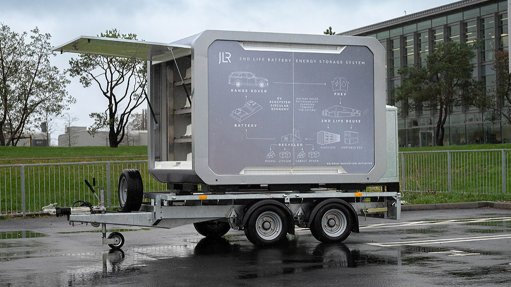CEO of Eskom
Dear Mr President, Members of Parliament and readers of Engineering News.
May I present the new candidate for CEO of State-owned electricity utility Eskom? It is myself, Terence Eric Mackenzie-Hoy. I am the ideal candidate, for the following reasons.
First, I am a qualified electrical engineer. This alone puts me almost 80% ahead of all the Eskom CEOs since Allen Morgan (2000). Second, I am registered with the Engineering Council of South Africa as a professional engineer – again, this puts me ahead. Third, I worked for Eskom as a senior engineer: operations (not for long). Trust me, if you know engineering operations, you are way, way ahead. Fourth, I can get things done, fearlessly. I have no career path. Once I get to be CEO of Eskom, I will seek no higher post. The fifth reason I am the ideal candidate is that I am really very, very smart. This means that I can be out of the gate and across the field before most are trying to find the lock. Finally, I have no political agenda. If Public Enterprises Minister Pravin Gordon tells me to cut power to all homes which have a Democratic Alliance sticker in the window, it will get done, provided the instruction will not be kept confidential.
As CEO, I can fix Eskom and make a lot of money as well. The things that have to be done are really very simple. Firstly, there are too many staff. Eskom staff costs are about R35-billion a year. The parastatal has about 47 000 staff but needs only 15 000. Getting rid of 32 000 staff will save R11-billion a year but, owing to retrenchment pay and Labour Court claims, the savings will only be realised two years after the staff reduction.
There will be strikes, but these will be settled and, in any event, can be dealt with. The approach to this is to install technical innovations that reduce labour components and, at staff level, decimate the Eskom training, sales and noncore business departments. Most important is to eliminate the ‘seminars, conferences and parties’ syndrome, which, in turn, eliminates the people who organise them.
On the maintenance side, power line surveys must increase, as must repair and maintenance teams associated with such surveys. District depots must take advantage of the game-playing ability of Millennials and must be issued with GPS-equipped and thermally equipped drones, which allows line inspections to be flown weekly. The cost of line maintenance per 100 km of power line per consumer must be reduced by half. Eskom must reduce its losses that are caused by illegal connections and failure by consumers to pay. To this end, the utility must give away or sell all distribution networks where power is supplied at low voltage. The new operators should be private organisations whose income will depend on getting the consumers to pay. If they do not pay Eskom, they will be cut off and have to deal with the consequences.
Eskom’s problems have been caused by corruption in coal supply systems and the intermittent operation of the coal conveyors that supply the so-called ‘tied mines’. Coal deliveries must move from truck fleets delivering to power stations. Instead, trucks must deliver to stockpiles of existing tied mines, which then deliver by conveyor to Eskom. This places coal corruption and delivery risk onto the hands of private miners.
At least one or more of the older power stations should be sold to the coal miners. They can use them to generate power and ‘wheel’ it through the network to supply themselves and other miners, which will stabilise and settle the electricity costs to the various mines.
Finally, last but not least, I am cheap. I do not want a salary of tens of millions rands – I will settle for R150 000 a month, and will need no bonus. But on these things I will not budge: I will not start work before 10:00. I will not attend more than one meeting a day. I will not attend any meeting lasting longer than one hour, even with the President. Minister Gordhan, I await your call.
Comments
Announcements
What's On
Subscribe to improve your user experience...
Option 1 (equivalent of R125 a month):
Receive a weekly copy of Creamer Media's Engineering News & Mining Weekly magazine
(print copy for those in South Africa and e-magazine for those outside of South Africa)
Receive daily email newsletters
Access to full search results
Access archive of magazine back copies
Access to Projects in Progress
Access to ONE Research Report of your choice in PDF format
Option 2 (equivalent of R375 a month):
All benefits from Option 1
PLUS
Access to Creamer Media's Research Channel Africa for ALL Research Reports, in PDF format, on various industrial and mining sectors
including Electricity; Water; Energy Transition; Hydrogen; Roads, Rail and Ports; Coal; Gold; Platinum; Battery Metals; etc.
Already a subscriber?
Forgotten your password?
Receive weekly copy of Creamer Media's Engineering News & Mining Weekly magazine (print copy for those in South Africa and e-magazine for those outside of South Africa)
➕
Recieve daily email newsletters
➕
Access to full search results
➕
Access archive of magazine back copies
➕
Access to Projects in Progress
➕
Access to ONE Research Report of your choice in PDF format
RESEARCH CHANNEL AFRICA
R4500 (equivalent of R375 a month)
SUBSCRIBEAll benefits from Option 1
➕
Access to Creamer Media's Research Channel Africa for ALL Research Reports on various industrial and mining sectors, in PDF format, including on:
Electricity
➕
Water
➕
Energy Transition
➕
Hydrogen
➕
Roads, Rail and Ports
➕
Coal
➕
Gold
➕
Platinum
➕
Battery Metals
➕
etc.
Receive all benefits from Option 1 or Option 2 delivered to numerous people at your company
➕
Multiple User names and Passwords for simultaneous log-ins
➕
Intranet integration access to all in your organisation


















